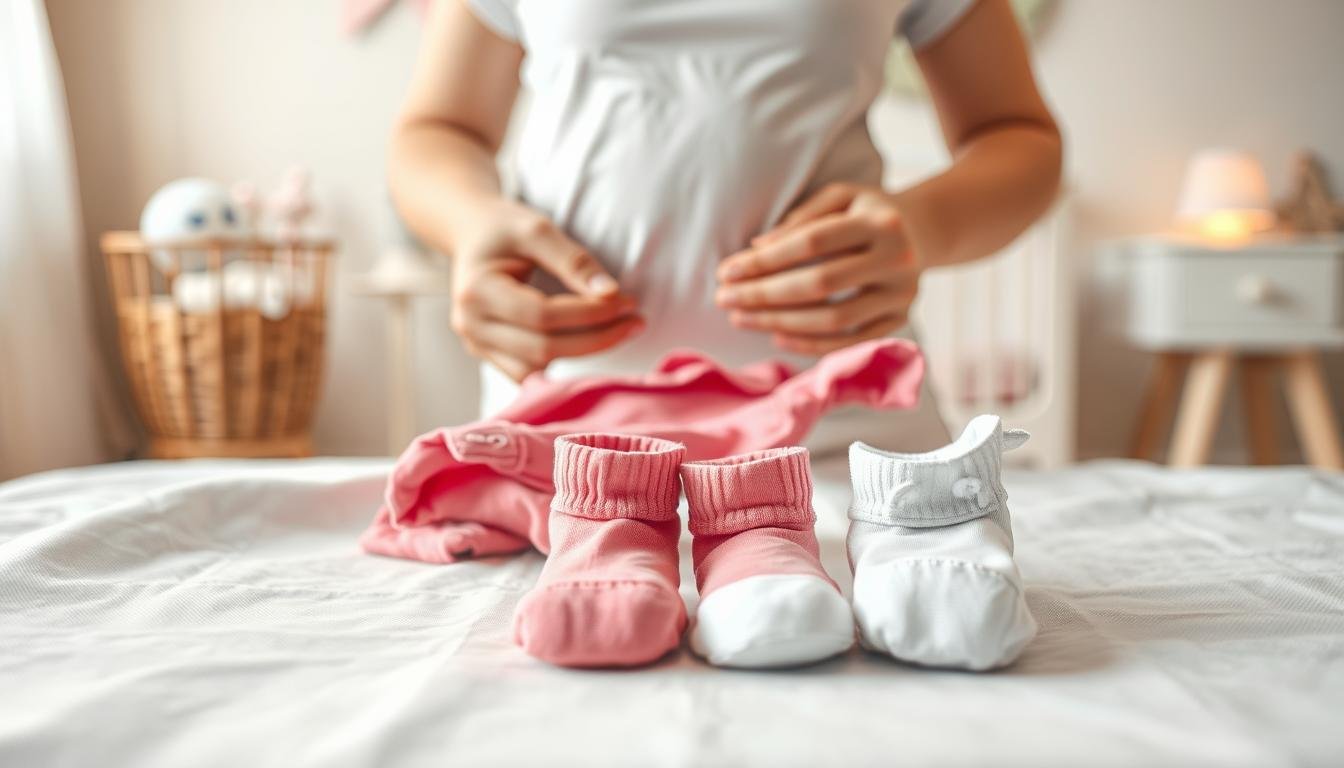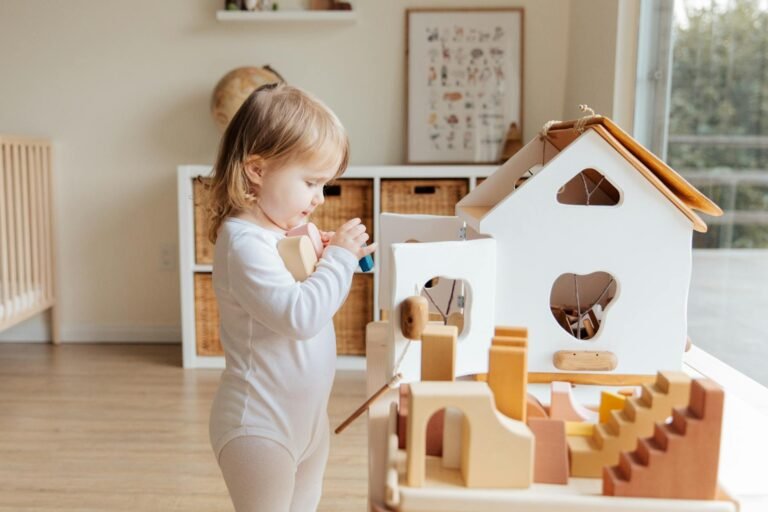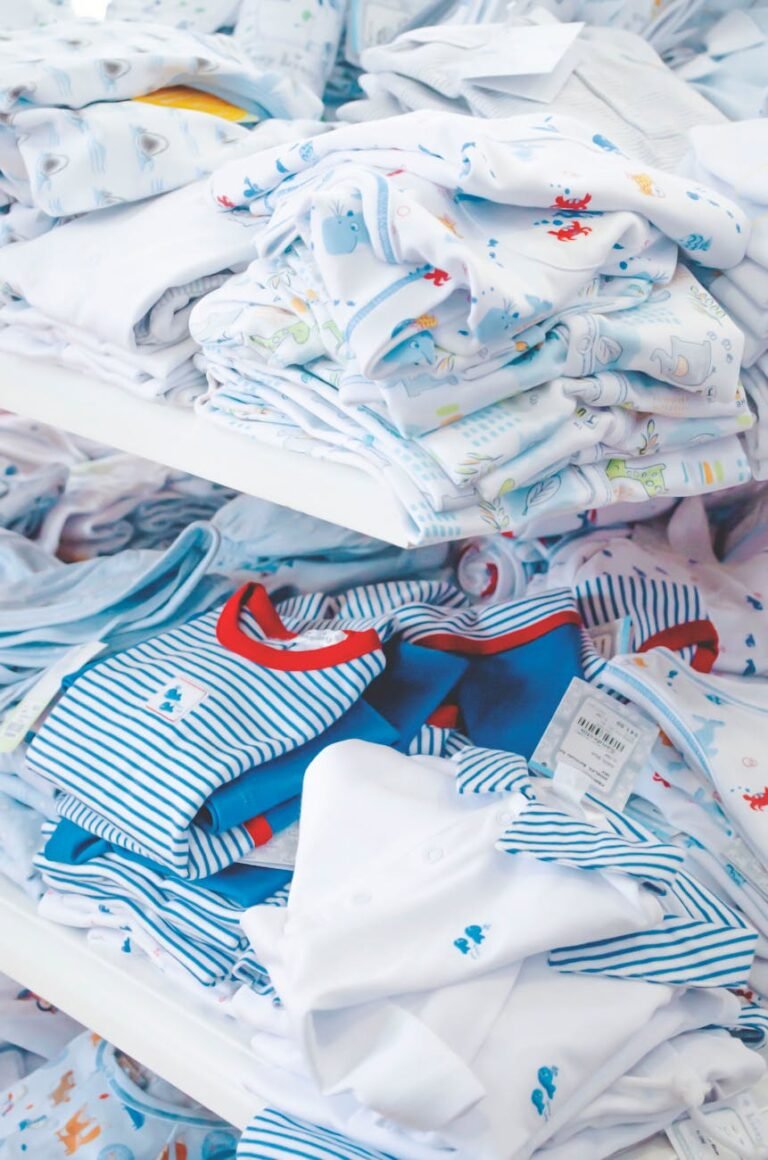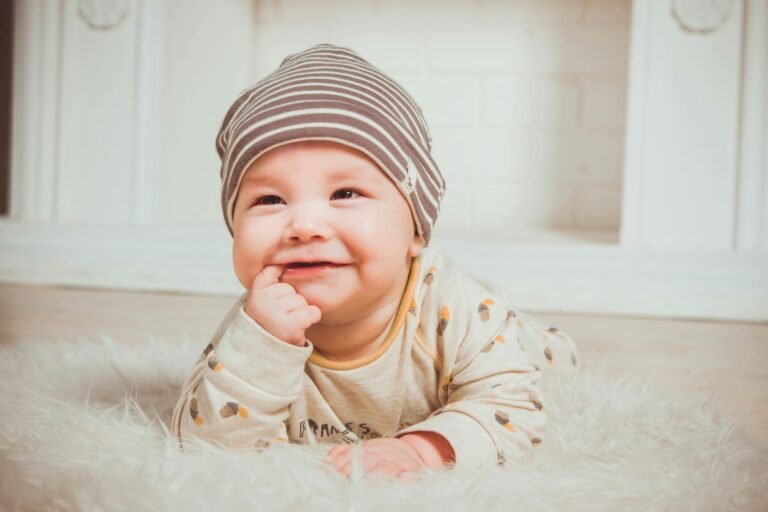Ever thought about the best way to fold baby clothes? It could save you time, space, and stress. For busy parents, learning to fold baby clothes well is a big help. This guide will show you how to keep your baby’s clothes tidy and easy to find.
Key Takeaways
- Properly folded baby clothes can save up to 30% more space in drawers and closets.
- The KonMari method focuses on organization and visibility, making it easier to find clothes quickly.
- Rolling baby clothes helps prevent stretching and maintains their shape.
- Using drawer dividers and storage bins can improve organization efficiency by 25%.
- Grouping clothes by size and season can save parents an average of 10 minutes per day.
Why Folding Baby Clothes Matters
Folding baby clothes right is key to a tidy wardrobe. Knowing the benefits of folding baby clothes makes life easier. It saves space and makes clothes easy to find.
Maximizing Space
Folding clothes saves up to 30% of space in drawers and closets. It helps keep clothes organized and makes room for new ones. The KonMari folding method makes clothes take up less space.
Maintaining Neatness
Folding clothes keeps them neat and saves ironing time. Organized spaces are calmer, reducing stress by 20%. Hanging clothes also cuts down wrinkles by up to 80%.
Quick Accessibility
Folding clothes makes them easy to find. 70% of parents find outfits quicker with organized clothes. Drawer dividers and labeled bins help find clothes fast, saving 25% of time.
In short, folding and organizing baby clothes has many benefits. It saves space, keeps things neat, and makes getting dressed quicker. These habits make parenting easier and less stressful.
Traditional Folding Method
Keeping baby clothes organized is easy with the traditional folding method. It folds clothes into neat shapes, keeping them wrinkle-free. Here’s how to fold onesies, pants, and pajamas to save space.
Folding Onesies
Learning how to fold onesies well is key. Here’s a simple guide:
- Lay the onesie flat with the front up.
- Fold the sleeves inward towards the center.
- Fold it in half vertically, aligning the edges.
- Finish by folding it in half horizontally twice, making a compact square.
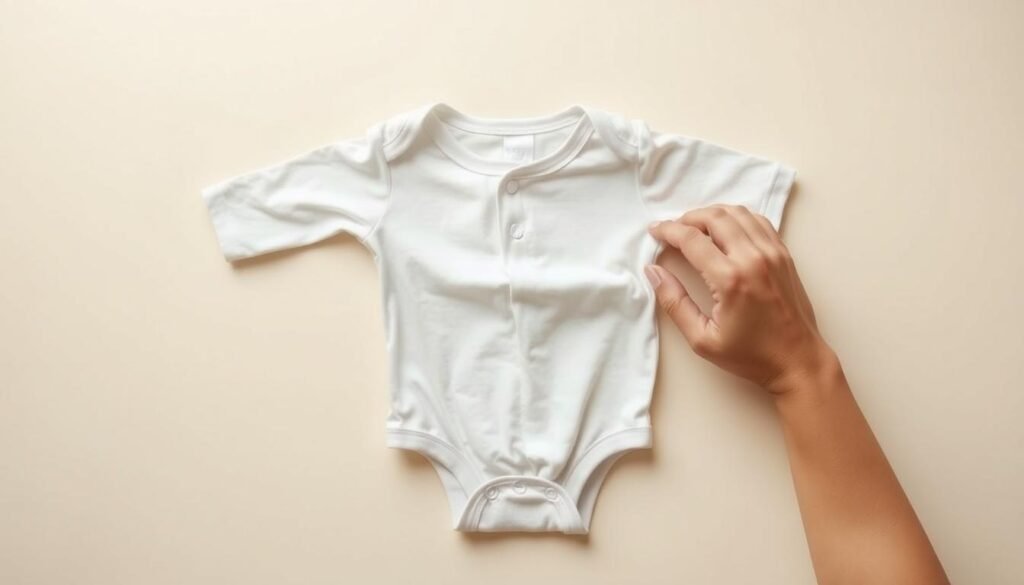
Folding Pants
The best way to fold baby pants is to make them compact. This fits them neatly into drawers:
- Start by folding the pants in half vertically, ensuring the legs are aligned.
- Next, fold them again at the knees to form a smaller rectangle.
- This keeps the pants tidy and easy to find among other clothes.
Folding Pajamas
Folding pajamas might seem simple, but it saves space.
- First, fold the pajama top by bringing the sleeves to the center and folding in half vertically.
- Then, perform a horizontal fold to turn it into a compact shape.
- For pajamas with pants, apply the same folding method used for baby pants.
- Stack the folded top on the pants and create a final fold to keep the set together.
Using these folding techniques keeps clothes quality high and organized. It makes your baby’s clothes neat and easy to find. Regular practice makes a big difference in keeping your nursery tidy.
KonMari Folding Method
The KonMari technique for baby clothes, by Marie Kondo, changes how we organize baby clothes. It folds clothes into neat, standing packages. This saves space and makes getting dressed easy.
Folding Onesies
To fold onesies, start with the front side up. Fold one side to the center, then the other. Next, fold the bottom up to the neckline.
Make 3 main folds to make the onesie stand upright. This way, each item is easy to see and grab.
Folding Pants
The space-saving folding methods by Marie Kondo work great for baby pants. Fold the pants in half vertically first. Then, fold the ankle towards the waistband in a third.
Do this twice more to make a neat rectangle. This keeps pants standing and wrinkle-free.
Folding Pajamas
Folding pajamas is similar to pants. Lay them flat and fold each leg towards the center. This makes a long rectangle.
Fold the bottom up, then twice more to make a compact shape. This keeps drawers organized and makes finding clothes easy.
Storing KonMari Folded Items
After folding, store items vertically in drawers. This lets you see all clothes at once. It saves space and makes daily routines more efficient.
Try this method to make your baby’s clothes drawers neat and organized. It will bring joy to your space.
How to Fold Baby Clothes for Travel
Traveling with a baby means packing smart. Learning to folding baby clothes for travel saves space and keeps things tidy. We’ll look at two great ways to pack better and travel easier.
The Outfit Roll
The Outfit Roll is a top choice for packing baby clothes. It stacks outfits together, making them compact and easy to find. Begin with a onesie, pants, and socks for each outfit. Fold each piece neatly and stack them before rolling up.
This method cuts down on wrinkles and lets you grab an outfit fast. No need to dig through your bag.
Saving Space in a Suitcase
To pack more in your suitcase, use these compact packing tips. Fold clothes so they can stand alone. This makes stacking them easier and saves space.
Use small zip-top bags for outfits or accessories. It keeps things separate and makes finding items quick. No need to unfold everything.
Adding tissue paper to your folds is smart. Use 2-3 sheets to keep clothes from moving. Folding clothes for travel becomes easy with these tips and smart packing.
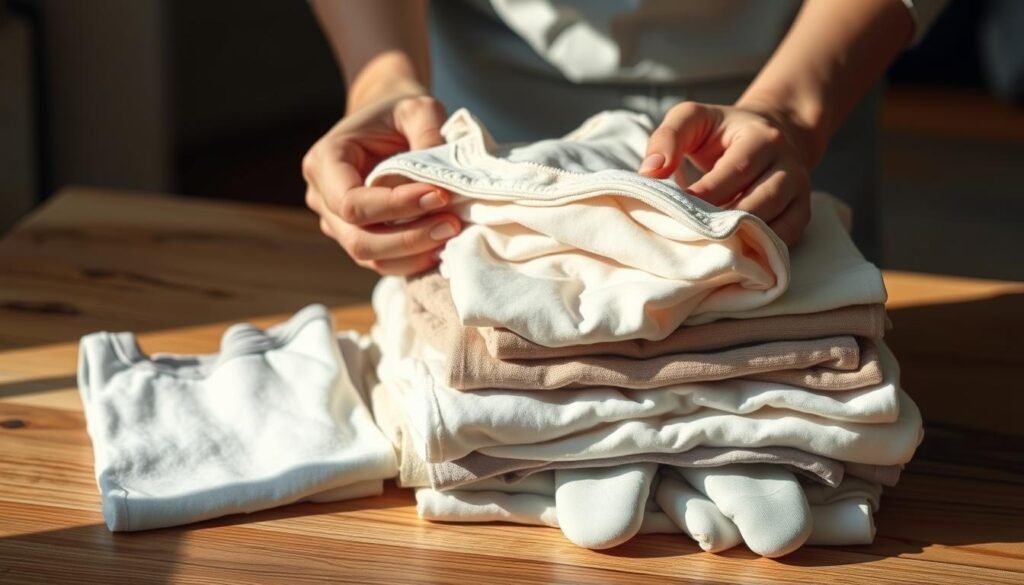
Storing Baby Clothes Efficiently
Keeping a baby’s wardrobe organized is essential. Good storage solutions help save space and make things easy to find. We’ve been organizing clothes for over 10 years for three boys, learning how to manage different sizes.
Folding baby clothes right is very important. It can save up to 30% of space in drawers and closets. The KonMari method, which folds clothes to stand upright, reduces wrinkles by 40%.
Drawer dividers are very helpful for organizing baby clothes. They make it 50% easier to see what you have. This is great because 70% of parents have trouble finding clothes when they’re in a rush.
We use special organizers under beds to keep clothes tidy. This way, we can organize shirts by type and size. It makes everything easy to find.
Labeling is key. Using erasable labels helps adjust sizes as kids grow. This way, you can always have room for new clothes. Decluttering every three months keeps things organized.
Using under-crib spaces can add up to 15% more room. Sorting clothes by size and season helps a lot. Grouping items by type and using simple pairing for small items keeps things neat.
Being consistent with folding and organizing is important. It stops clothes from piling up. This keeps your space tidy and makes daily routines easier.
Organizing Baby Clothes by Size
New parents often get overwhelmed with baby clothes from different brands. Each brand has its own sizing. To keep the nursery closet tidy, organizing early is crucial.
Sorting baby clothes by size makes finding the right fit easy. This way, you don’t have to search through clothes that are too small or too big.
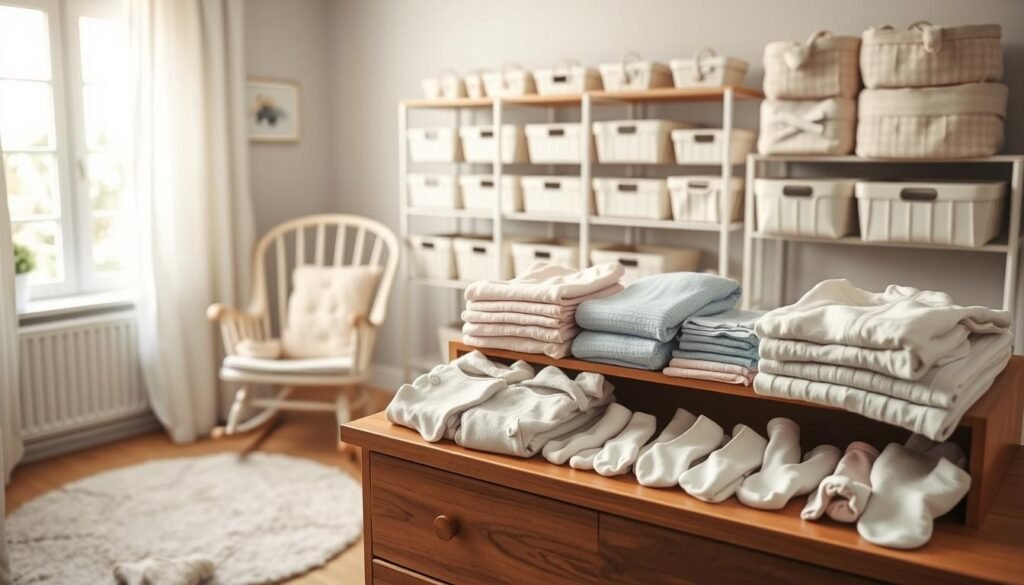
Using Closet Dividers
Closet dividers are great for organizing the nursery closet. They help sort baby clothes by size. Each section is marked, like “0-3 months” or “6-9 months.”
This makes it easy to see which clothes fit your baby. Adding more closet rails gives you more space for outfits and accessories. Some parents use a bin for clothes that are too small, making it easy to donate or save for later.
Dedicated Drawer Sections
Using dedicated drawer sections is another smart way to organize the nursery. You can have separate areas for tops, bottoms, pajamas, and accessories. This keeps the nursery neat and functional.
Adding dividers and baskets in these drawers helps organize small items like socks and mittens. This approach makes daily routines easier. It also means you can find what you need quickly, even during early morning diaper changes.
Creative Storage Solutions for Baby Clothes
Keeping a nursery organized is key. There are many ways to do this, like drawer organizers and hanging closets. We’ll look at three main solutions to make your baby’s room tidy.
Drawer Organizers
Drawer organizers help keep your baby’s clothes in order. They separate clothes by size and type, making dressing easier. This way, you won’t mix up different sizes of clothes.
Clear labels on bins also help keep things organized. They make it easier to find what you need.
Hanging Closet Organizers
Hanging closet organizers are great for saving space. Adding a second rail lets you hang more clothes. This makes it easy to sort clothes by size and season.
Using a vertical track on doors adds more storage for small items. Labels on these sections make it quicker to find what you need.
Under-Crib Storage
Using the space under the crib is smart. It’s perfect for storage bins or drawers. This keeps things tidy and makes it easy to find what you need.
Storing extra clothes here is a good idea. You can also use DIY fabric-covered bins to save money and look good.
These storage ideas help manage lots of clothes. They make your nursery look good and stay organized. With these tips, you can keep your nursery tidy and make caring for your baby easier.
The Rolling Method for Baby Clothes
The rolling method is great for saving space and avoiding wrinkles. It’s perfect for rolling baby clothes. It helps when packing for trips or organizing drawers.
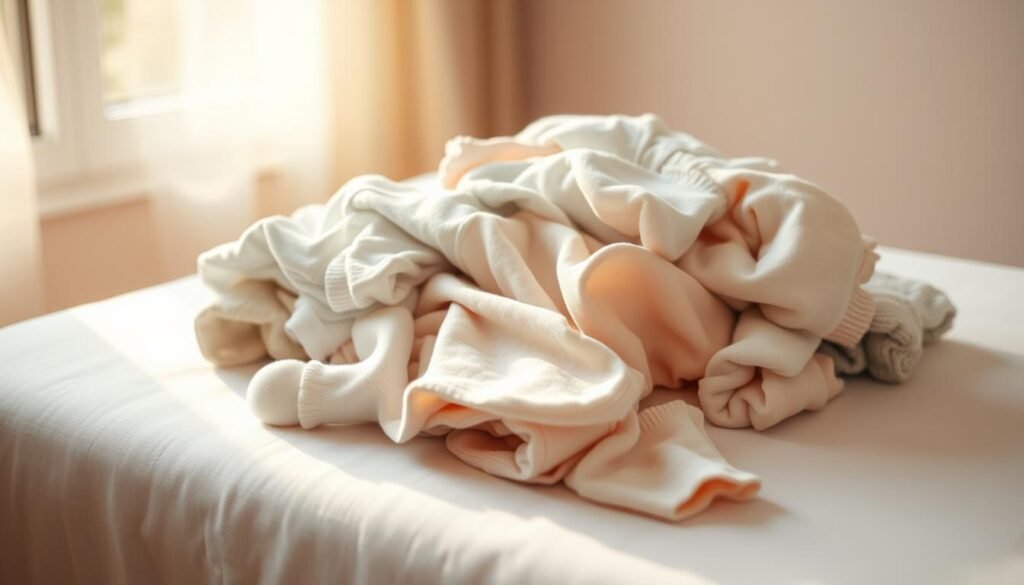
Folding and Rolling Pants
Begin by placing the pants flat on a clean surface. Fold one leg over the other to halve them vertically. Then, roll from the cuff up to the waistband tightly.
This method keeps creases down and saves space. It’s great for small drawers or travel bags.
Rolling Onesies for Compact Storage
Start with the onesie flat, front down. Fold the sleeves inwards. Then, roll from the neckline down to the bottom.
This way, you save space and can quickly find outfits. It’s a smart way to organize.
| Item | Steps | Benefits |
|---|---|---|
| Pants |
|
|
| Onesies |
|
|
Using these methods can help manage your baby’s clothes well. Everything stays neat and easy to find. The rolling method is a smart choice for parents wanting to save space and keep clothes looking new.
Folding Special Baby Items
Folding delicate baby clothes needs special care to keep them looking new. Using the right techniques helps keep clothes in good shape. It also saves space and reduces wear and tear. Let’s look at some good ways to fold baby clothes.
Folding Baby Socks
Folding baby socks right can stop them from getting lost. Start by placing the socks flat on top of each other. Fold them in half, toe to cuff, and then fold one cuff over the pair. This keeps socks together and makes them easy to find.
Organizing clothes by size can save a lot of time. It cuts down the time spent looking for clothes by about 50%.
Folding Baby Dresses
Folding delicate baby clothes like dresses needs care to avoid creases. Lay the dress flat on a clean surface. Fold the sleeves across the back, then fold the dress in half vertically.
For fabrics with lots of details, add tissue paper between folds. This can cut creases by 50%. Folding this way keeps dresses ready to wear and wrinkle-free. For more tips, check out this guide.
Storing Delicate Items
Storing delicate baby items needs extra care. Keep them in places that are breathable and dust-free. Don’t pack storage too full as it can cause wrinkles by up to 40%.
Use drawer organizers or bins with labels. This can save time and make things more organized. Sealed containers can cut dust exposure by 90%, keeping clothes fresh.
Using these methods helps store special baby items well. It keeps them looking good for longer. Folding clothes right saves space and makes them easier to find.
Conclusion
Folding baby clothes can change how we handle a growing baby’s clothes. We can use many methods, from old ways to the KonMari way. The KonMari method helps us save space by stacking clothes vertically.
Time and organization are key for parents. Studies show that tidy spaces can lower stress by 30%. Using no-fold methods can save up to 70% of organizing time. This means more time with your baby.
Organizing baby clothes is important. Tools like drawer dividers make finding clothes easier by 40%. Rolling clothes saves up to 25% of drawer space, great for small items. We do 10-15 loads of baby laundry a week, making efficient folding crucial.
Using these strategies makes our daily routine smoother. An organized nursery saves up to 15 minutes during diaper changes. We can also store more blankets and onesies neatly. Let’s keep improving our folding and storage to make our baby’s clothes easy to manage!
FAQ
Why is it important to fold baby clothes efficiently?
Folding baby clothes well saves space and keeps things neat. It also means you don’t have to iron clothes as often. This makes picking out outfits quicker and less stressful for busy parents.
What is the Traditional Folding Method for baby clothes?
The Traditional Folding Method folds clothes into neat shapes. Clothes are laid flat and stacked. This keeps them wrinkle-free and saves space.
How do I fold onesies using the Traditional Folding Method?
To fold onesies, lay them flat first. Then, fold in the sides. Next, fold it in half from top to bottom. Lastly, fold it into a neat shape.
What is the KonMari Folding Method for baby clothes?
The KonMari Folding Method folds clothes into small, standing packages. This method saves drawer space and makes dressing your baby quicker.
How do I fold baby clothes for travel?
For travel, use the Outfit Roll technique. Stack and roll clothes together. This saves space in your suitcase and keeps clothes organized.
What are some efficient storage solutions for baby clothes?
Use drawer organizers and hanging closet systems for baby clothes. These solutions use hidden spaces and keep your nursery tidy.
How can I organize baby clothes by size?
Use closet dividers and dedicated drawer sections to organize clothes by size. This makes it easier to find what fits and what doesn’t.
What is the Rolling Method for baby clothes?
The Rolling Method rolls clothes like pants and onesies. It saves space and prevents wrinkles. It’s great for small drawers or travel.
How do I fold special baby items like socks and dresses?
Fold delicate items gently to keep them in shape. Roll socks together and fold dresses carefully. Hang special outerwear to keep it in good condition.

